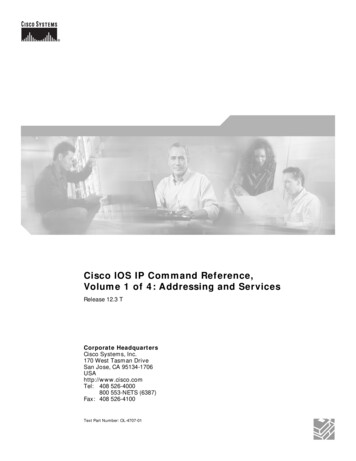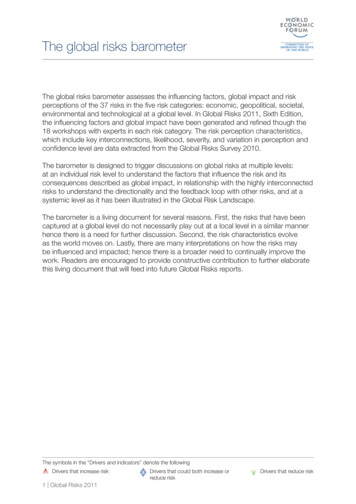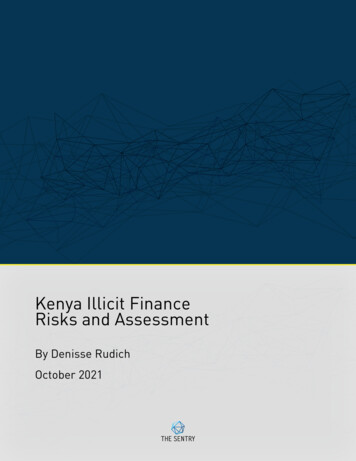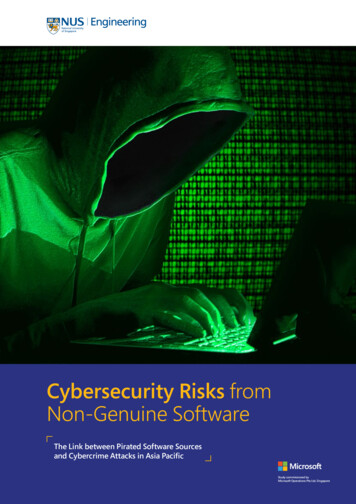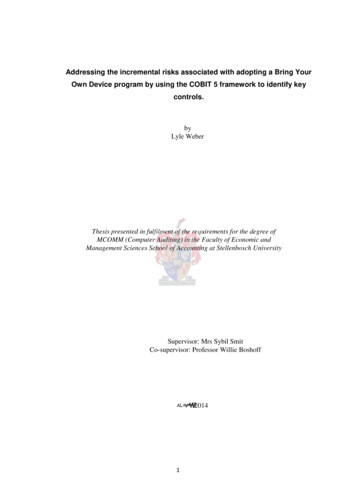
Transcription
Addressing the incremental risks associated with adopting a Bring YourOwn Device program by using the COBIT 5 framework to identify keycontrols.byLyle WeberThesis presented in fulfilment of the requirements for the degree ofMCOMM (Computer Auditing) in the Faculty of Economic andManagement Sciences School of Accounting at Stellenbosch UniversitySupervisor: Mrs Sybil SmitCo-supervisor: Professor Willie Boshoff SULO 20141
Stellenbosch University http://scholar.sun.ac.zaDeclarationBy submitting this thesis electronically, I declare that the entirety of the workcontained therein is my own, original work, that I am the sole author thereof (save tothe extent explicitly otherwise stated), that reproduction and publication thereof byStellenbosch University will not infringe any third party rights and that I have notpreviously in its entirety or in part submitted it for obtaining any qualification.December 2013Copyright 2014 Stellenbosch UniversityAll rights reserved2
Stellenbosch University http://scholar.sun.ac.zaACKNOWLEDGEMENTSI want to thank GOD the FATHER for HIS LOVE, My LORD and SAVIOURJESUS CHRIST for being a great example and the HOLY SPIRIT who greatlyassisted and guided me with during the course of the research.I would also like to thank my dad (Gavin Weber), my mom (Glenda Weber)and my two sisters (Jamie-Leigh Weber and Kayla Chandre’ Weber) for theircontinuous love, support and encouragement.Finally I would like to thank my supervisor Ms. Sybil Smits for her guidancethroughout the process and continuous words of encouragement too.3
Stellenbosch University http://scholar.sun.ac.zaABSTRACTBring Your Own Device (BYOD) is a technological trend which individuals ofall ages are embracing. BYOD involves an employee of an organisation usingtheir own mobile devices to access their organisations network. Severalincremental risks will arise as a result of adoption of a BYOD program by anorganisation. The research aims to assist organisations to identify whatincremental risks they could potentially encounter if they adopt a BYODprogram and how they can use a framework like COBIT 5 in order to reducethe incremental risks to an acceptable level. By means of an extensiveliterature review the study revealed 50 incremental risks which arise as aresult of the adoption of a BYOD program. COBIT 5 was identified as themost appropriate framework which could be used to map the incremental risksagainst. Possible safeguards were identified from the mapping process whichwould reduce the incremental risks to an acceptable level. It was identifiedthat 13 of the 37 COBIT 5 processes were applicable for the study.4
Stellenbosch University http://scholar.sun.ac.zaContentsCHAPTER 1: INTRODUCTION . 71.1Background . 71.2Problem statement . 81.3Objective . 91.4Scope of the research . 91.5Research motivation . 91.6Organisation of the research . 10CHAPTER 2: RESEARCH METHODOLOGY . 122.1Purpose of the study . 122.2Literature study . 122.3Research methodology . 122.4Conclusion . 13CHAPTER 3: LITERATURE REVIEW . 143.1BYOD . 143.2 Strategic incremental concerns and risks . 163.2.1 Malware . 163.2.2 Data leakage . 173.2.3 Theft or loss of mobile devices . 183.2.4 Connectivity of the device (Bluetooth and Wi-Fi) . 183.2.5 Web based applications . 193.2.6 Compliance with laws and regulations governing the organisation . 203.2.7 Obsolescence . 203.3 Operational concerns and risks . 21Ability of IT to support BYOD programs. 213.4 Summary of the incremental information technology strategic and operational risks andconcerns identified. . 234. CHAPTER 4: SELECTION OF FRAMEWORK . 334.1 Selection of control framework . 334.2 COBIT 5 . 334.3 Identification of applicable COBIT 5 processes which affect BYOD Programs . 37CHAPTER 5: FINDINGS ON THE INCREMENTAL INFORMATION TECHNOLOGYSTRATEGIC AND OPERATIONAL RISKS WHICH ARISE WHEN AN ORGANISATIONADOPTS A BYOD PROGRAM . 67CHAPTER 6: CONCLUSION AND FURTHER RESEARCH . 805
Stellenbosch University http://scholar.sun.ac.za6.1 Conclusion . 806.2 Future research. 80REFERENCES . 81List of Tables1. Table 1 . 232. Table 2 . 353. Table 3 . 384. Table 4 . 535. Table 5 . 666
Stellenbosch University http://scholar.sun.ac.zaCHAPTER 1: INTRODUCTION1.1 BackgroundWhat started out several years ago with individuals using their own personalcomputers to access their organisations networks via dial up and virtualprivate networks has changed dramatically in recent years.There has been an extensive rise in the number of smart phone and tabletcomputer sales in recent years. Gupta, A. et al (2013) indicated that globalsmartphone sales reached 225 million units in the second quarter of 2013.Deloitte (2013) indicated that there are over 10 million active smartphones inSouth Africa.With the increased number of smartphone and tablet computers circulatingin the market place, it comes as no surprise that more and more individualsare making use of their personal mobile devices to connect to theirorganisations networks. Whilst there are benefits which the organisationderives such as cost saving and happier employees - which results inincreased productivity, there are incremental risks which arise as well. Theconcept where an employee uses his/her own personal mobile device toconnect to the organisation’s network is known as Bring Your Own Device(BYOD).BYOD has been embraced by a large number of organisations of varioussizes and in various sectors.Some employees use their mobile devices to perform basic tasks such assyncing their work emails and calendars with their mobile devices, whereasother employees use their mobile devices to perform specific work relatedtasks such as compiling Excel spread sheets and accessing sensitivecorporate data.7
Stellenbosch University http://scholar.sun.ac.zaFailure on the behalf of the organisation to implement sound internal controlsand governance policies to address the risks associated with BYOD couldlead to the organisation suffering dire consequences. These consequencesinclude, but are not limited to: heavy financial losses, and the risk of potentially closing down, Ifo if sensitive client data is leaked into the public arena as a resultof data theft, oro where malware infiltrates the network and corrupts the data orcauses the information technology system to shut down.The governance of the incremental risks should not only be of interest tothose charged with governance of the organisation, but to the external auditoras well. The auditor would need to understand which incremental risks havearisen as a result of the adoption of the BYOD program. Failure to adequatelyidentify these incremental risks could result in the auditor expressing aninappropriate audit opinion.Most of the research conducted to date on BYOD programs looks at thebenefits of adopting such programs and to a lesser extent, the incrementalrisks associated with the implementation of BYOD programs.This research will therefore produce valuable information for organisationswishing to adopt a BYOD program, organisations that currently run BYODprograms and external auditors.1.2 Problem statementAn organisation that adopts or deploys a BYOD program will be faced withincreased incremental information technology strategic and operational risks.These organisations will need to identify suitable internal controls in order toreduce the incremental risks to an acceptable level.8
Stellenbosch University http://scholar.sun.ac.za1.3 ObjectiveThe objective of this study is to develop a framework to identify and managethe incremental information technology strategic and operational risks whicharise when an organisation adopts a BYOD program.The study will focus mainly on the incremental strategic risks which arise asa result of the adoption of a BYOD program and to a lesser extent on theincremental operational risks which arise when an organisation adopts aBYOD program.1.4 Scope of the researchIt is not the purpose of this research to identify all the incremental risks thatan organisation will encounter as a result of adopting or deploying a BYODprogram, neither the identification of all the controls and safeguards which anorganisation could adopt to reduce the incremental risks to an acceptablelevel.The research is also limited to information technology strategic andoperational incremental risks which arise when adopting a BYOD program.1.5 Research motivationMost research relating to BYOD has been conducted by privateorganisations such as IBM, Gartner, ISACA and Forrester.The benefits arising from BYOD have been widely researched, asdocumented by some, including Pelino (2012); DAT (2012) and Anderson9
Stellenbosch University http://scholar.sun.ac.za(2013). However only a limited amount of research has been conducted todate on the risks and concerns which arise when an organisation adopts aBYOD program. Rose’s (2012) article indicates that there are securityimplications which arise as a result of BYOD. Markelj and Bernik’s (2012)article indicates the threats that arise as a result of using mobile devices andthe impact on corporate data security.A practical integrated framework will assist those charged with governanceat the organisation in mitigating the risks associated with the adoption anddeployment of a BYOD program to an acceptable level.The findings of the research conducted may be used as a guideline inassessing the incremental information technology strategic and operationalrisks which may exist at the organisation as a result of the organisationadopting a BYOD program. The findings may also be used to identify keycontrols that could be deployed to reduce the incremental risks to anacceptable level.1.6 Organisation of the researchThe dissertation will consist of the following chapters:Chapter 2: Research methodology: A comprehensive literature review wasperformed and a practical integrated framework was developed based on thefindings of the literature review.Chapter 3: Literature review: An extensive literature review was conductedto identify the incremental information technology strategic and operationalrisks which arise as a result of an organisation adopting a BYOD program.Chapter 4: Selection of control framework: Motivation for the selection ofCOBIT 5 as the framework to be used in this study.Chapter 5: Findings on the incremental information technology strategicand operational risks which arise when an organisation adopts a BYOD10
Stellenbosch University http://scholar.sun.ac.zaprogram: Incremental risks identified during the study were mapped againstpossible controls and safeguards to reduce the risks to an acceptable level.Chapter 6: Conclusion: This chapter contains an overview of the research,highlighting the outcomes of the research findings and discusses futureresearch to be conducted.11
Stellenbosch University http://scholar.sun.ac.zaCHAPTER 2: RESEARCH METHODOLOGY2.1 Purpose of the studyThe aim of this study is to identify key internal controls and safeguards whichan organisation can deploy by using the COBIT 5 framework as a basis toreduce the information technology strategic and operational risks identified toan acceptable level. The study is non-empirical in nature and the resultsdrawn are from an extensive literature review.2.2 Literature studyAn extensive literature review was performed on BYOD and the COBIT 5framework.The following considerations highlight some of the key areas focused onduring the literature review: Risks and concerns relating to BYOD programs, Compliance and legal considerations which arise as a result of BYOD, The behaviour of employees whilst using their own devices, Implications of mobile devices being stolen or lost, and The COBIT 5 framework.2.3 Research methodologyIn order to identify the key internal controls needed by an organisation toreduce the incremental information technology strategic and operational riskswhich arise as a result of an organisation adopting a BYOD program to anacceptable level, the following steps were taken:Step 1: Conduct an extensive literature review on BYOD.12
Stellenbosch University http://scholar.sun.ac.zaStep 2: The incremental information technology strategic and operationalrisks were summarised in tabular format.Step 3: Select a control framework.Step 4: Identified which COBIT 5 processes were applicable for the purposeof this study.Step 5: Mapping of COBIT 5 to the risks identified during the extensiveliterature review was tabularised.Step 6: Possible safeguards or controls for the incremental informationtechnology strategic and operational risks identified in step 2 weresummarised in tabular format.2.4 ConclusionBy implementing the above-mentioned methodology at both a strategic andan operational level, it will be shown that compliance with IT governanceprinciples is possible at both the strategic and operational levels.13
Stellenbosch University http://scholar.sun.ac.zaCHAPTER 3: LITERATURE REVIEW3.1 BYODMobile devices (USB’s, tablet computers, laptops, smartphones) of allshapes and sizes have become a part of our daily lives.The concept of BYOD (Bring Your Own Device) involves permitting anemployee to connect their own personal mobile devices to the organisationsnetwork and applications. The BYOD concept has been adopted byorganisations, both governmental and non-governmental of all sizes andacross all industries (Burt, 2011; Gatewood, 2012; Willis, 2013b).Gupta, A. et al (2013) indicated that smartphone sales to end users havereached 225 million units in the second quarter of 2013 and Rohan (2013)stated that employees are using their personal mobile devices for official workpurposes.If organisations do not support employees in their wish to use their ownpersonal devices for work purposes, the employees may figure out ways tosupport their devices themselves. This will place sensitive corporate data atrisk. It is therefore important that organisations enable employees to get theirwork done in the most appropriate manner without compromising the integrityof the data. (Kanaracus, 2012)Whilst it is not the purpose of this paper to discuss the benefits associatedwith the adoption or deployment of a BYOD program, a few benefits are listed.The benefits include, but are not limited to: Increase in productivity of employees (Pelino, 2012; (DAT, 2012),2012; Anderson, 2013) Increased revenue (Pelino, 2012); and Reduction in expenses for corporate-liable mobile device and dataservices (Pelino, 2012; DAT, 2012).14
Stellenbosch University http://scholar.sun.ac.zaBased on the abovementioned benefits it is understandable why manyorganisations would be inclined to opt for the adoption and deployment ofBYOD programs. It should however be noted that whilst the benefits are good,failure to consider the concerns and risks surrounding the adoption ordeployment of a BYOD program noted by industry experts, could have direconsequences on the organisation.Several concerns and risks were identified during the extensive literaturereview that was conducted. The concerns and risks identified arise as a resultof an organisation deploying a BYOD program. These concerns and risksindentified have been classified as either strategic or operational in nature andhave been discussed below in section 3.2 and 3.3.15
Stellenbosch University http://scholar.sun.ac.za3.2 Strategic incremental concerns and risks3.2.1 MalwareMalware enables hackers to steal passwords and in some cases evencreates an opportunity for the hacker to take control of the organisationscomputer systems, including those that run smartphones and tablets (Staut,2012).With the BYOD concept being adopted on an increased basis byorganisations across all business sectors, it comes as no surprise that manyorganisations are increasingly being affected by malware. This is due to thefact that there has been an increase in the amount of new malicioussmartphone and tablet targeting software (Drew, 2012; Kaspersky, 2012;Ponemon Institute LLC, 2012; Lung Kao, 2011).The Ponemon Institute LLC (2012) indicated that traditional securitysolutions which most organisations employ, such as antivirus, firewalls, andpasswords are not effective at stopping malicious or negligent employees ofthe organisation from deploying advanced malware into the organisationscomputer systems.Users who access the Internet from their mobile devices are at constant riskof exposure to web-based threats, including data stealing malware. When adevice downloads a new mobile application from any online application store,the software may contain malware that can steal or damage data on thedevice and, in some cases, even disable the mobile device itself (CISCO,2013).According to the Cisco survey results, 69% of BYOD users were usingunapproved applications on their devices, which is difficult to detect (Cisco,cited in DAT, 2012). The recent staggering increase in Android malwaremagnifies this problem (DAT, 2012).If an organisation fails to have proper internal controls in place to managethe risks associated with malware, the organisation could find itself being thetarget of some or other malicious malware attack which could have adisastrous impact on the organisation.16
Stellenbosch University http://scholar.sun.ac.za3.2.2 Data leakageEach organisation has different types of data which they deal with on a dailybasis. Some data types are more sensitive than others, e.g. documentscontaining trade secrets or confidential client information would be moreimportant than the organisations policy on whistle blowing. The risksassociated with data leakage on mobile platforms have become a biggerproblem than malware (Willis, 2013b).It is for this reason that organisations should be interested in safeguardingtheir data in order to prevent unauthorised individuals from gaining access towhat could be seen as their most important asset.If an organisation has deployed a BYOD program, there is a high probabilitythat employees will sync their mobile devices with their home computers. Thisincreases the risk of data leakage as the employee’s home computer mayalready be infected with malware such as Trojan horses and spyware whichwould compromise the security of corporate data. If the employee’s homecomputer has any unpatched vulnerabilities, this will grant cybercriminals theability to gain access to the mobile data that has been backed up, stored orsynced onto the employee’s home computer (Kaspersky, 2012).Willis, (2013b) stated that most mobile devices are designed to share datavia the cloud. Rouse, (2010) indicates that cloud computing involvesdelivering hosted services over the internet. Whilst Cloud based sharing andstorage of personal data is convenient, employees may forward sensitivedocuments and presentations relating to the organisation to their personalemail like Google Mail or file storage services like Dropbox so that they canaccess the information on their mobile device at a later stage. This wouldcreate a “shadow infrastructure” over which the organisation will have little tono control and will result in a direct increase in the risk of data leakage takingplace (Anderson, 2013; IBM, 2011).The Ponemon Institute found the average organizational cost of a databreach increased to US 7.2 million and cost companies an average ofUS 214 per compromised record (IBM, 2012).Failure on behalf of an organisation to safeguard their data through theimplementation of proper internal controls could result in the organisation notonly suffering legal action and huge financial losses, but depending on theextent of the breach, could cause irreparable damage on the organisationsability to continue in the future.17
Stellenbosch University http://scholar.sun.ac.za3.2.3 Theft or loss of mobile devicesMobile devices are popular amongst individuals of all ages. These devicesare generally compact in nature, yet they have the ability to be used toperform similar tasks to most personal computers. It should come as nosurprise that in a report prepared by IBM (2011) as well as researchconducted by Markelj and Bernik (2012), that the most frequently seen mobiledevice security threats are the loss and the theft of these devices.The loss of a personal smartphone or tablet on which an employee hasdownloaded confidential data of the organisation, creates an opportunity for acriminal to access the organisations confidential information. This representsa serious security risk for the organisation (Kaspersky, 2012). This isespecially the case where the employee has not followed basic securitypractises such as locking the device with a strong password and encryptingsensitive data transmitted to and from the mobile device (Staut, 2012).Mobile data-bearing devices that were lost or stolen may contain sensitive orconfidential information (Ponemon Institute LLC, 2012; Drew, 2012). The datastored on the device may be compromised if access to the device or the datais not effectively controlled (Evangelista, 2013). The risk of unauthorisedaccess to the data is further increased as most organisations do not have theability to remotely wipe a device if a smartphone is lost or stolen. Mostemployees do not know what to do if their device was lost or stolen (Rose,2012).It is for this reason that users of mobile devices need to take some form ofprecautionary measure to ensure that they too do not form part of thepopulation of individuals who have lost their mobile device or have had itstolen from them.3.2.4 Connectivity of the device (Bluetooth and Wi-Fi)Mobile devices offer broad Internet and network connectivity through varyingchannels including, but not limited to Bluetooth and Wi-Fi technology.Anderson (2013) stated that when an authenticated device has other devicestethered to it, it may be possible for non-authenticated devices and users togain access to the corporate network by connecting through the authenticateddevice. The threat to the corporate network is further increased as Bluetooth18
Stellenbosch University http://scholar.sun.ac.zaand Wi-Fi technology can be easily exploited to infect a mobile device withmalware or compromise transmitted data (IBM, 2011).When a Bluetooth device is set on discoverable mode, it makes it very easyto scan for the device using a computer. Once the computer is connected tothe device the computer is able to download the private data located on thedevice (Cisco, 2013).Users who make use of Bluetooth and Wi-Fi technology to connect to theInternet or to share information should be mindful that these channels may notbe as safe as what they may have originally thought.3.2.5 Web based applicationsWeb based applications are quite often designed by individuals who theowner of the mobile device may not know personally. Mobile device usersnormally download applications which are of interest to them onto their mobiledevices.There are more than 700 000 apps in the Apple App Store and more than700 000 apps in the Android Marketplace (Tibken, 2012).When a device downloads a new mobile application from any onlineapplication store, the software may contain malware that can steal or damagedata on the device and, in some cases, even disable the mobile device itself.It is not possible for application store owners to conduct in-depth code reviewsof all applications (IBM, 2012; IBM, 2011). Anderson (2013) indicated thatindividuals are more than likely to use their personal mobile devices to accessboth personal and business applications.An IBM survey conducted on several hundred of their employees revealedthat many of their employees were completely unaware which popular appswere security risks (Rose, 2012). The risks are further increased by the recentstaggering increase in Android malware (DAT, 2012).Web based applications can therefore cause a substantial amount ofdamage to the organisations IT infrastructure if the use of these applicationsare not properly controlled.19
Stellenbosch University http://scholar.sun.ac.za3.2.6 Compliance with laws and regulations governing the organisationComplying with the laws and regulations governing the industry andgeographical region in which an organisation finds itself, should always be apriority for any organisation. Failure to adhere to laws and regulationsaffecting the organisation could result in the organisation being liable for largefines or penalties for breach of the relevant laws and regulations.McQuire (2012) indicated that organisations operating in highly regulatedindustries cannot afford any compromise to customer data records or thecompliance requirements governing these industries. McQuire stated in thesame research paper, that in certain countries like Germany, the federal lawconcerning data protection stipulates that German company data must residein Europe.Research conducted by Vodafone (2012) indicated that it is important thatorganisations ensure regulatory compliance, especially where employees arepermitted to run corporate email on their devices as this may be subject tosome form of communication regulations. They also noted that it is moredifficult to ensure compliance where the organisation does not own thedevice.Where an employee uses software purchased for their personal mobiledevices under "personal use" licenses for business purposes, the organisationmay not be complying with the rules governing the use of the software andmay be liable for the additional costs (O’Brien, 2013).There is a possibility that it will be more challenging for organisations toensure that they are complying with the rules and regulations affecting them inthe future. This is especially true with the constant technologicaladvancements taking place and the manner in which data is shared andtransferred from one device to the next.3.2.7 ObsolescenceNew mobile devices are released into the market on a regular basis. Themanufacturers of these devices have done a great job in convincingindividuals to upgrade from their exist
COBIT 5 was identified as the most appropriate framework which could be used to map the incremental risks against. Possible safeguards were identified from the mapping process which would reduce the incremental risks to an acceptable level. It was identified that 13 of the 37 COBIT 5 processes were applicable for the study.


